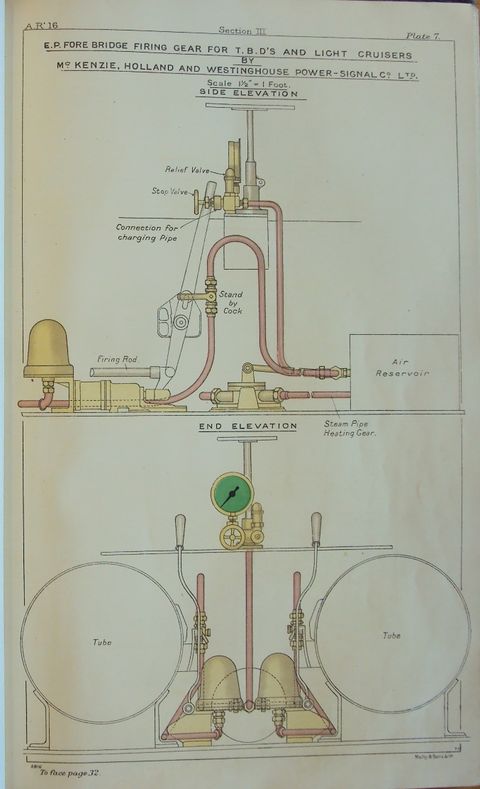Fore Bridge Firing Gear: Difference between revisions
(Created page with ''''Fore Bridge Firing Gear''' is equipment to permit torpedoes to be fired from a ship's fore bridge rather than at the torpedo tubes themselves. The British had an on-again, of…') |
m (→Post-Jutland) |
||
| Line 8: | Line 8: | ||
==Post-Jutland== | ==Post-Jutland== | ||
[[File: | [[File:ARTS1916Plate7.jpg|thumb|480px| Electro-Pneumatic Fore Bridge Firing Gear<ref>''Annual Report of the Torpedo School, 1916'', Plate 7.</ref>]] | ||
By the end of 1916, <ref>''Annual Report of the Torpedo School, 1916'', pp. 31-32.</ref> the Royal Navy had changed its mind, recording that "[e]xperience during the war having shown the necessity for controlling the fire from a position on the bridge near the Captain, fore bridge firing fear for A.W. tubes had to be revived." Trials in ''Parker'' with an electro-pneumatic trigger were "most successful", and was found to fire the torpedo in 0.43 seconds, whereas a design from [[Portsmouth Dockyard]] produced firings in 0.60 seconds with a hydraulic medium and 0.50 seconds in pneumatic use. A purely hydraulic system from ''Vernon'' based on [[Newitt Mine Release Gear|Newitt's mine release gear]] was also tested. | By the end of 1916, <ref>''Annual Report of the Torpedo School, 1916'', pp. 31-32.</ref> the Royal Navy had changed its mind, recording that "[e]xperience during the war having shown the necessity for controlling the fire from a position on the bridge near the Captain, fore bridge firing fear for A.W. tubes had to be revived." Trials in ''Parker'' with an electro-pneumatic trigger were "most successful", and was found to fire the torpedo in 0.43 seconds, whereas a design from [[Portsmouth Dockyard]] produced firings in 0.60 seconds with a hydraulic medium and 0.50 seconds in pneumatic use. A purely hydraulic system from ''Vernon'' based on [[Newitt Mine Release Gear|Newitt's mine release gear]] was also tested. | ||
Revision as of 16:21, 14 June 2011
Fore Bridge Firing Gear is equipment to permit torpedoes to be fired from a ship's fore bridge rather than at the torpedo tubes themselves. The British had an on-again, off-again love affair with it, especially on her destroyers.
Early Use
Some of the River, Tribal and Beagle class destroyers had electrically-fired powder charges which rammed the firing shaft of the tube. It worked, albeit with some missfires most often attributable to bad grounding.
Abandonment
In 1911, based on trials, the practice was discarded in consideration of missfires and the lateral error introduced by aiming from a position some distance from the tube. While this same issue was the basis for the use of Tangent Bars on the Torpedo Directors, in 1916, the earlier decision to drop the practice was rationalised as being due to "the close-range attacks then in vogue", which highlighted the error, but in the same breath, the opinion is voiced that sober thought indicates that the error is likely small at any range when compared to errors in estimating the other parameters of the firing solution.[1]
Post-Jutland

By the end of 1916, [3] the Royal Navy had changed its mind, recording that "[e]xperience during the war having shown the necessity for controlling the fire from a position on the bridge near the Captain, fore bridge firing fear for A.W. tubes had to be revived." Trials in Parker with an electro-pneumatic trigger were "most successful", and was found to fire the torpedo in 0.43 seconds, whereas a design from Portsmouth Dockyard produced firings in 0.60 seconds with a hydraulic medium and 0.50 seconds in pneumatic use. A purely hydraulic system from Vernon based on Newitt's mine release gear was also tested.
On 24 July, 1916, it was decided that destroyers should have a torpedo control position between the searchlight pedestal and the wheel, with a sighting device placed on a central stand atop the roof, able to see either side. A platform for the T.C. officer to stand on, a windscreen just forward, and order and deflection transmitters, fire gong pushes and fore bridge firing gear right below him completed the mandated alterations to existing destroyers and those under construction.[4]
See Also
Footnotes
Bibliography